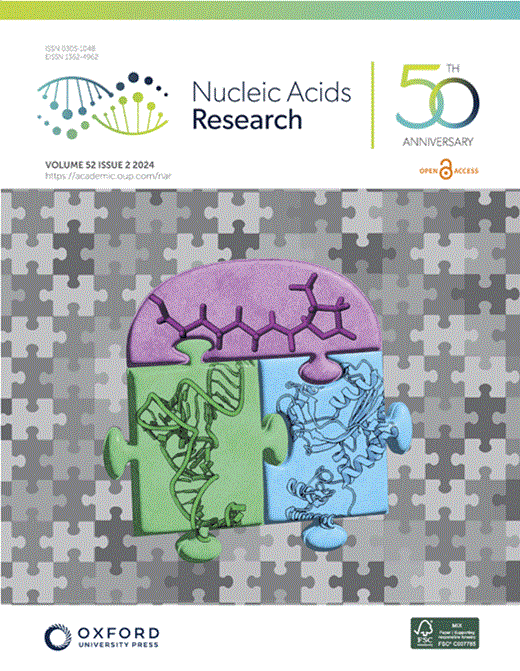Poly-(ADP-ribose) serves as a scaffold for the methyltransferase METTL3/14 complex in the DNA damage response
IF 16.6
2区 生物学
Q1 BIOCHEMISTRY & MOLECULAR BIOLOGY
引用次数: 0
Abstract
PARP1, a crucial DNA break sensor, synthesizes poly-(ADP-ribose) (PAR), a nucleic acid that promotes the recruitment of DNA repair proteins. Emerging evidence highlights a role of RNA and RNA-binding proteins in DNA repair. Notably, the RNA–m6A methyltransferase complex METTL3/14 is implicated in repairing ultraviolet-induced DNA lesions. Here, we dissected the interplay between the two nucleic acids PAR and RNA and how METTL3/14 recruitment and m6A accumulation at laser-induced DNA lesions responds to PAR dynamics. In vitro, METTL3/14 recognized both PAR and RNA, yet PAR presence did not inhibit the methyltransferase complex’s catalytic activity. Acute knock-out of METTL3 rendered cells sensitive to transcription-blocking DNA damage and resulted in defects in transcription recovery and transcription-coupled DNA repair. Furthermore, combining METTL3 and PARP inhibitors led to an enhanced antiproliferative effect on cancer cells. Future therapeutic avenues may thus leverage the interplay between the nucleic acids PAR and RNA.聚(ADP-核糖)是 DNA 损伤反应中甲基转移酶 METTL3/14 复合物的支架
本文章由计算机程序翻译,如有差异,请以英文原文为准。
求助全文
约1分钟内获得全文
求助全文
来源期刊

Nucleic Acids Research
生物-生化与分子生物学
CiteScore
27.10
自引率
4.70%
发文量
1057
审稿时长
2 months
期刊介绍:
Nucleic Acids Research (NAR) is a scientific journal that publishes research on various aspects of nucleic acids and proteins involved in nucleic acid metabolism and interactions. It covers areas such as chemistry and synthetic biology, computational biology, gene regulation, chromatin and epigenetics, genome integrity, repair and replication, genomics, molecular biology, nucleic acid enzymes, RNA, and structural biology. The journal also includes a Survey and Summary section for brief reviews. Additionally, each year, the first issue is dedicated to biological databases, and an issue in July focuses on web-based software resources for the biological community. Nucleic Acids Research is indexed by several services including Abstracts on Hygiene and Communicable Diseases, Animal Breeding Abstracts, Agricultural Engineering Abstracts, Agbiotech News and Information, BIOSIS Previews, CAB Abstracts, and EMBASE.
 求助内容:
求助内容: 应助结果提醒方式:
应助结果提醒方式:


